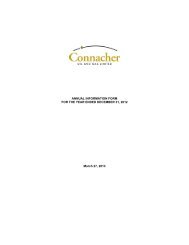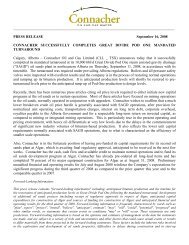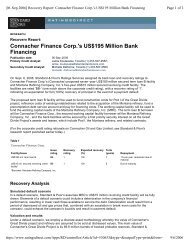ANNUAL REPORT 2011 - Connacher Oil and Gas
ANNUAL REPORT 2011 - Connacher Oil and Gas
ANNUAL REPORT 2011 - Connacher Oil and Gas
You also want an ePaper? Increase the reach of your titles
YUMPU automatically turns print PDFs into web optimized ePapers that Google loves.
AR <strong>2011</strong><br />
PG 56<br />
earnings (loss) at the end of each respective reporting period based on the changes in fair value of the contracts. The estimated fair value of all risk<br />
management contracts is derived from third–party market indications <strong>and</strong> forecasts. Attributable transaction costs are recorded in net earnings (loss).<br />
The company accounts for its forward physical delivery sales <strong>and</strong> purchase contracts that are entered into <strong>and</strong> continued to be held for the purpose<br />
of receipt or delivery of non–financial items in accordance with its expected purchase, sale or usage requirements, as executory contracts. As such,<br />
these contracts are not considered derivative financial instruments <strong>and</strong> thus have not been recorded on the consolidated balance sheet. Settlements<br />
of these physical sales <strong>and</strong> purchase contracts are recognized in related revenues <strong>and</strong> expenses.<br />
Derivatives embedded within contracts that are not already required to be recognized at fair value, <strong>and</strong> that are not closely related to the host contract<br />
in terms of economic characteristics <strong>and</strong> risks, are separated from their host contract <strong>and</strong> recognized at fair value; associated gains <strong>and</strong> losses are<br />
recognized in net earnings (loss). The company has no material embedded derivatives.<br />
3.14 Revenue recognition<br />
Revenue from sales of bitumen, crude oil, natural gas <strong>and</strong> refined products is recognized at the fair value of consideration received or receivable, after<br />
deducting royalties, when title passes to the customer. For sales by upstream operations, this generally occurs when product is physically transferred<br />
into a pipe, delivery trucks are accepted by the customer, or railcars have been transloaded. For sales by downstream operations, it is either at the<br />
loading or delivery point, depending on contractual conditions.<br />
3.15 Finance charges<br />
Finance charges comprise interest expense on long–term debt, amortization of transaction costs <strong>and</strong> st<strong>and</strong>–by fees of the Facility, unwinding of the<br />
discount on decommissioning liabilities, unrealized gain/loss on revaluation of convertible debentures <strong>and</strong> share purchase warrants, bank charges <strong>and</strong><br />
any impairment losses recognized on financial assets.<br />
Finance charges directly attributable to the acquisition, construction or production of qualifying assets, which are assets that necessarily take a<br />
substantial period of time to get ready for their intended use, are added to the cost of those assets, until such time as the assets are substantially<br />
ready for their intended use. All other finance costs are recognized in net earnings (loss) in the period in which they are incurred using the effective<br />
interest method. Interest has been capitalized at the rate of interest applicable to the specific borrowings financing the asset, or where financed<br />
through general borrowings, at a capitalization rate representing the average interest rate on such borrowings.<br />
3.16 Earnings (loss) per share<br />
The company presents basic <strong>and</strong> diluted earnings (loss) per share data for its common shares. Basic earnings (loss) per share is calculated by dividing<br />
net earnings (loss) attributable to ordinary equity holders of the company by the weighted average number of common shares outst<strong>and</strong>ing during<br />
the period. Diluted earnings (loss) per share is determined by adjusting the earnings or loss attributable to common shareholders <strong>and</strong> the weighted<br />
average number of common shares outst<strong>and</strong>ing for the effects of dilutive instruments, which may include convertible debentures, stock options, share<br />
incentive awards <strong>and</strong> share units.<br />
3.17 Non–current assets classified as held for sale<br />
Non–current assets, or disposal groups comprising assets <strong>and</strong> liabilities, that are expected to be recovered primarily through sale rather than<br />
through continuing use, are classified as held for sale. Immediately before classification as held for sale, the assets, or components of a disposal<br />
group, are remeasured in accordance with the company’s accounting policies. Thereafter, the assets, or disposal group, are measured at the lower<br />
of their carrying amount <strong>and</strong> fair value less cost to sell. Impairment losses on initial classification as held for sale <strong>and</strong> subsequent gains or losses on<br />
remeasurement are recognized in net earnings (loss). Property, plant <strong>and</strong> equipment classified as held for sale are not depleted or depreciated <strong>and</strong><br />
investment in associate classified as held for sale is not equity accounted.<br />
3.18 Fair value measurements<br />
Fair value measurements are estimates of the amounts for which assets or liabilities could be exchanged at the measurement date, based on<br />
the assumption that such exchanges take place between knowledgeable, unrelated parties in unforced transactions. Where available, fair value<br />
measurements are derived from prices quoted in active markets for identical assets or liabilities. In the absence of such information, other observable<br />
inputs are used to estimate fair value. Where publicly available information is not available, fair value is determined using estimation techniques that take<br />
into account market perspectives relevant to the asset or liability so as far as they can reasonably be ascertained, based on predominantly unobservable<br />
inputs. For risk management contracts <strong>and</strong> for share–based compensation plans, fair value estimations are generally determined using models <strong>and</strong><br />
other valuation methods, the key inputs for which include future prices, volatility, price correlation, counterparty credit risk <strong>and</strong> market liquidity, as<br />
appropriate; for other assets <strong>and</strong> liabilities, fair value estimations are generally based on the net present value of expected future cash flows.<br />
3.19 Recent accounting pronouncements issued but not yet adopted<br />
The company has reviewed new <strong>and</strong> revised accounting pronouncements that have been issued but are not yet effective for the financial year<br />
beginning January 1, <strong>2011</strong> <strong>and</strong> determined that the following may have an impact on the company:












